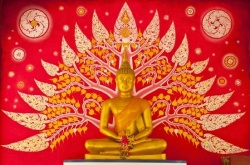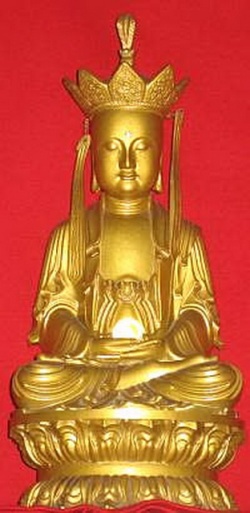Sanskrit Buddhist Canon
- Of this Sanskrit canon no complete copy is to be found. We know it only from larger or smaller fragments of its Udānavarga, Dharmapada, Ekottarāgama and Madhyamāgama which have been discovered from the xylographs and manuscripts recovered from Eastern Turkistan by Stein, Grunwedel and Le Coq, as well as from quotations in other Buddhist Sanskrit texts like the Mahāvastu, Divyāvadāna and Lalitavistara and finally from Chinese and Tibetan translations.
The literature of Central Asian discoveries has already assumed great proportions.
The more important references are: Pischel, Fragments of a Sanskrit Canon of the Buddhist from Idykutsari in Chinese Turkistan, Sitzungsberichte der Weiner Akadamie der Wissenschaften 1904, p. 807. New Fragments, ibid p. 1138; The Turfan Recensions of the Dhammapada, Sitzungsberichte der Weiner Akadamie der Wissenschaften 1908, p. 968. What, however, Pischel regarded as the recensions of the Dhammapada are in reality fragments of the Udānavarga of Dharmatrāta, the Tibetan translation of which has been rendered into English by Rockhill in 1883, and the Sanskrit original of which Luders is going to edit from the Turfan finds.
Vallee Poussin has discovered fragments of the same work in the collection brought from Central Asia by Stein and there is found Udāna [verses] corresponding to [those in] the Pāḷi Udāna (Journale Asiatique, 1912, p. 10, vol. xix, p. 311). Levi, Journale Asiatique, 1910, p. 10 vol. xvi, p. 444.
On the other hand the ancient Kharoṣṭhī manuscript discovered in Khotan by Dutreuil de Rheins, important equally from the standpoint of palaeography and literary history, represents an anthology prepared after the model of the Dhammapada in Prakrit (Comptes rendus de l'Academie des inscriptions, May 1895 and April 1898; Stein, Ancient Khotan, 1188; Senart Orientalistenkongresse XI, Paris, 1897, i, i, seq. Journale Asiatique 1898, p. 9, vol XII, [8] 193, 545; Luders Nachrichten von der K. Gesellschaft der Wissenschaften zu Gottingen 1899, p. 474; Rhys Davids Journal of the Royal Asiatic Society, 1899, p. 426, and Franke Zeitschrift der Deutschen Morgenlandischen Gesellschaft 60, 1906, p. 477).
Buddhist Sūtras in Sanskrit inscribed on bricks have been found by V. A. Smith and W. Hoey in the ruins of Gopalpur along with inscriptions ranging between 250 and 400 A.D. (Journal of the Asiatic Society of Bengal proceedings, 1896, p. 99).
For translations into Chinese and Tibetan, see Oldenberg Zeitschift der Deutschen Morgenlandischen Gesellschaft 52, pp. 654, 662; Anesaki Le Museon, new series xx, vi 1905, pp. 22-37. On a Chinese translation of a “Nirvāṇasūtra”, see Journal of the Royal Asiatic Society 1881, p. 66.
To the Vinayapiṭaka of the same canon belongs probably also the fragment of a ritual for the initiation of monks written in Sanskrit which was found in Nepal by Bendal as well as the Prātimokṣasūtra which is inferred from one Tibetan and four Chinese translations.
Album Kern, p. 373, and Orientalistenkongresse xiii, Hamburg, 1902, p. 58. S. Levi discovered the fragment of a Vinayapiṭaka of the Sārvāstivādis in the Tokharian (Journale Asiatique 1912, p. 10, vol. xix, p. 101, Oldenberg Zeitschift der Deutschen Morgenlandischen Gesellschaft 52, p. 645.)
The principal texts of the canon of the MūlaSārvāstivādis - this is the designation of the Sanskrit canon according to tradition - were translated from Sanskrit into Chinese in 700-712 by the Chinese pilgrim I-tsing.
J. Takakusu, a record of Buddhist religion by I-tsing, translated, Oxford 1896, p. XXXVII. See Anesaki Journal of the Royal Asiatic Society 1901, p. 895; Ed. Huber in Bulletin de l'Ecole Francaise d'Extreme Orient VI 1906, p. 1, Sylvain Levi in the Toung Pao, V. 1904, p. 297; VIII, 110.
A sub-division of the MūlaSārvāstivādis are the Sārvāstivādis who had a Vinaya of their own just as the other three sub-divisions of the same school, viz., the Dharmaguptas, Mahīśāsakas and Kāśyapīyas (Levi ibid. p. 114, 1907).
But the Chinese ‘Tripiṭaka’ does not mean the same [9] thing as the Pāḷi Tipiṭaka but contains also many non-canonical texts and even philosophical treatises of Brahmanism (Takakusu, Journal of the Royal Asiatic Society 1896, p. 415.)
Likewise in the Tibetan Kanjur which is also denominated ‘Tripiṭaka,’ there is much which has no comparison with the Tipiṭaka of Pāḷi and which doubtless does not belong to the ancient canon.
As in these so also in the Chinese and Tibetan, there are the sub-divisions into Vinaya, Sūtra and Abhidharma.
This Sanskrit canon in its Chinese rendering betrays in the texts and in the arrangements of its component books many coincidences with the Pāḷi canon and on the other hand many deviations from it.
This is to be explained by assuming that the Pāḷi canon was first translated in some part of India first from a common source, probably the lost Māgadhi canon and later on in another province the Sanskrit canon branched itself off.
According to Sylvain Levi (Toung Pao 1907, p. 116) the Vinaya of the Sanskrit canon was first codified in the 3rd or 4th century after Christ.
In the Sanskrit canon the Āgamas correspond to the Nikāyas in Pāḷi, the Dīrghāgama answering to the Dīghanikāya, the Madhyamāgama to the Majjhimanikāya, the Ekottarāgama to the Aṅguttaranikāya and the Saṁyuktāgama to the Samyuttanikāya.
There was also a “Kṣudraka” corresponding to the Khuddakanikāya.
Whether in this latter all those texts were included which in the Pāḷi canon are embodied in this Nikāya we do not know but we know that in the Sanskrit canon also there were corresponding to the Pāḷi texts of Suttanipāta a Sūtranipāta, Udāna corresponding to Udāna, to Dhammapada a Dharmapada, to Theragāthā a Sthaviragāthā, to Vimānavatthu a Vimānavaṣṭu and to Buddhavaṁsa a Buddhavaṁśa.
It is doubtful whether the collection of the “seven Abhidharmas” [10] which stands translated in the Chinese Tripiṭaka was also derived from the ancient canon in as much as these Abhidharmas have nothing in common with the Abhidhammapiṭaka of the Pāḷi canon except the numeral seven and a few titles.
J. Takakusu, Journal of the Royal Asiatic Society. 1905, p. 138 and Journal of the Pali Text Society, 1905, p. 67,
Thus if the canon of the MūlaSārvāstivādis has been preserved only incompletely, the other Sanskrit Buddhist sects likewise give no closed canon, each having only one or more texts to which was accorded special sanctity as a kind of Bible and which assimilated the older texts of a Tripiṭaka recognised as such in principle and rejecting others. [11]


